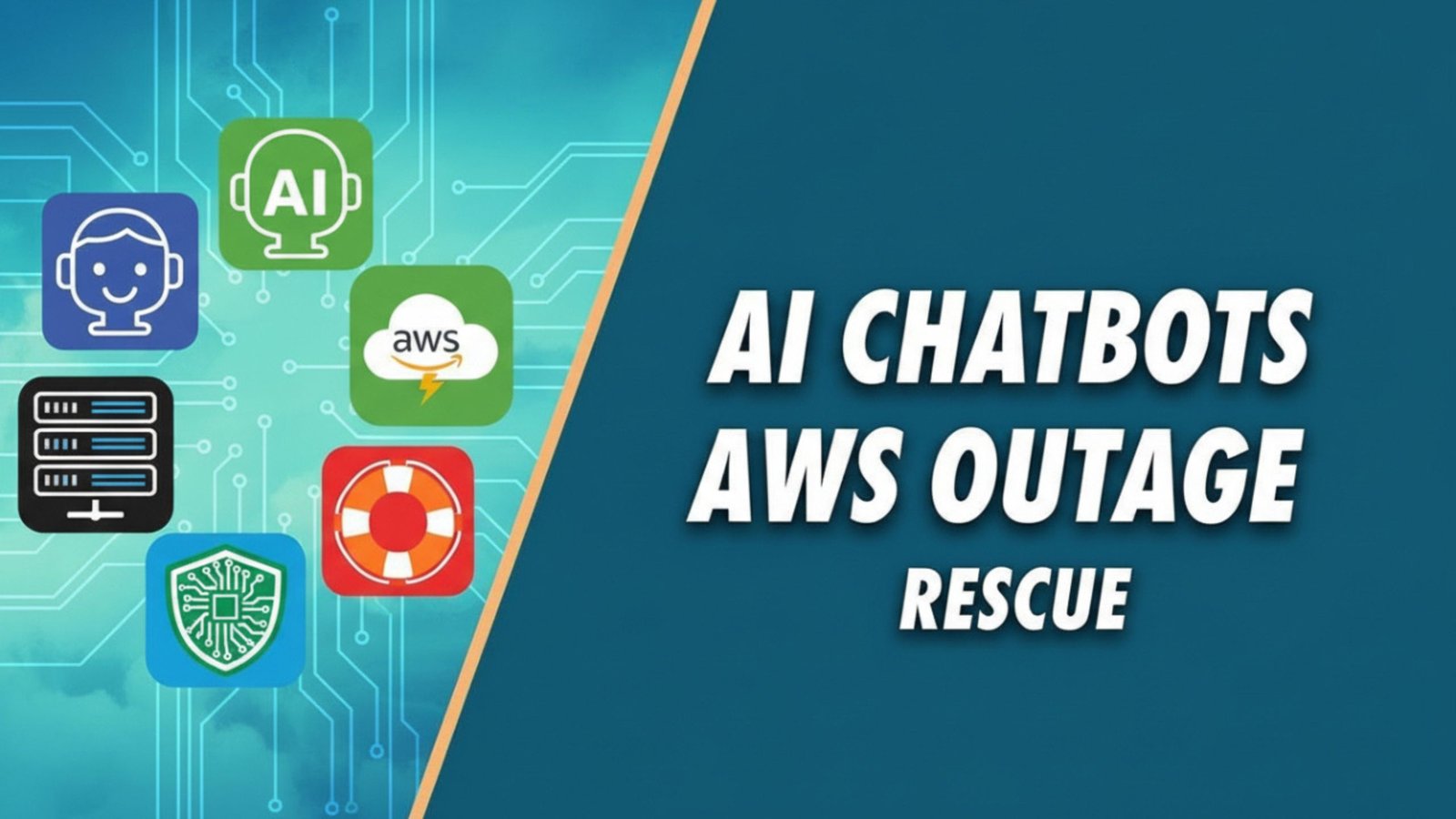The recent AWS outage created chaos across the digital world, shutting down websites, applications, and essential online tools. For many professionals and businesses that rely on cloud computing, this disruption felt catastrophic. Yet, amid the blackout, one surprising hero emerged — AI chatbots. In this article, we explore how these intelligent assistants became indispensable when the world’s biggest cloud infrastructure faltered.
The Impact of the AWS Outage on Global Businesses
When Amazon Web Services (AWS) went down, the internet experienced a ripple effect. Businesses using AWS for hosting, storage, and APIs were suddenly offline. From e-commerce giants to AI-powered SaaS platforms, operations halted. Customer service queues piled up, transactions failed, and websites crashed.
Reports showed that the outage affected millions of websites, including financial services, media companies, and healthcare providers. The downtime highlighted a hard truth — even the most resilient systems are vulnerable. However, it also brought forth an unexpected savior: AI chatbots hosted on alternative networks and platforms.
AI Chatbots: The Unexpected Heroes
While AWS struggled, AI chatbots continued functioning smoothly, especially those running on independent infrastructures like OpenAI, Google Cloud, or on-device AI models. These bots became a bridge between users and businesses when all else failed.
For example:
- Customer inquiries were still answered even when websites were inaccessible.
- Support operations continued through social media and chat platforms.
- Automation tools kept internal communications alive for remote teams.
These chatbots, driven by advanced natural language processing (NLP), didn’t just offer automated responses — they delivered context-aware support, enabling organizations to maintain engagement despite backend chaos.
How AI Chatbots Function During Cloud Failures
Modern AI chatbots have evolved far beyond basic scripting. They use distributed architectures and redundant data routing, meaning even if one cloud provider goes down, they can switch to secondary nodes.
Here’s how they managed to stay operational during the AWS outage:
- Multi-Cloud Deployments – Many advanced AI systems are hosted across multiple cloud providers (e.g., Google Cloud, Microsoft Azure) to ensure uptime redundancy.
- Edge AI Computing – Certain AI chatbots run locally or on devices, minimizing dependency on a centralized server.
- API Failover Systems – If AWS APIs fail, chatbots can reroute through alternative endpoints or cached responses.
- Self-Learning Memory – AI assistants like ChatGPT and others maintain conversational continuity using cached memory or local logs.
This technical resilience turned AI chatbots into lifesavers for professionals who needed real-time assistance during downtime.
How AI Chatbots Supported Businesses During the AWS Crisis
When critical systems were offline, AI chatbots took over essential tasks, ensuring minimal disruption. Some major benefits included:
1. Continuous Customer Engagement
With websites down, customers turned to social platforms and messaging apps. AI chatbots integrated with these channels ensured that communication lines stayed open. Businesses used bots to inform users about the outage, expected recovery times, and alternative contact methods.
2. Automated Internal Support
Companies facing downtime relied on internal AI bots to manage workflows. These bots assisted with incident tracking, status updates, and employee coordination, ensuring that IT and support teams could respond swiftly.
3. Real-Time Crisis Management
AI systems analyzed live data feeds and social chatter to identify the scale of the outage. They helped PR and communication teams manage transparency with customers through automated, tone-appropriate updates.
4. Knowledge Retention and Training
Even when documentation servers were unreachable, AI chatbots with embedded knowledge bases offered quick solutions, FAQs, and procedural guidance — empowering staff to act confidently amid system failures.
The Future of Business Continuity with AI Chatbots
The AWS outage served as a wake-up call for organizations to rethink their business continuity strategies. AI chatbots are no longer support tools — they’re now part of disaster recovery frameworks.
Here’s how they’re shaping the future:
- Hybrid AI Infrastructure: Deploying bots across multiple clouds ensures no single point of failure.
- On-Device AI Processing: As edge computing grows, more chatbots will function independently of cloud servers.
- AI-Driven Analytics for Outage Prediction: Predictive AI models can now detect early signs of cloud instability and alert teams before full-scale downtime.
- 24/7 Autonomous Assistance: Chatbots will manage not just communication but also workflow automation, ticket escalation, and real-time monitoring.
Businesses integrating these features are not only enhancing efficiency but also bulletproofing their customer experience against future outages.
Human-AI Collaboration During Outages
AI chatbots are not meant to replace humans but to augment their capabilities, especially under stress conditions like system outages. During the AWS incident, many businesses leveraged this partnership effectively.
- AI handled repetitive queries, while humans managed complex or emotional customer interactions.
- Teams used AI tools to gather outage reports, compile customer feedback, and prepare press releases faster.
- AI-powered translation enabled global communication even when multilingual support teams were unavailable.
This synergy between humans and machines highlights how resilient digital ecosystems can emerge from crises.
What We Learned from the AWS Outage
The AWS downtime reinforced three vital lessons for the global tech community:
- Dependency breeds vulnerability – Relying solely on one provider exposes critical weaknesses.
- AI diversification is essential – Deploying AI chatbots across varied infrastructures guarantees uninterrupted assistance.
- Automation equals survival – In times of digital breakdown, automation tools maintain stability and continuity.
Organizations that had already invested in AI chatbot integration fared far better than those without automation frameworks. The takeaway is clear: AI readiness is no longer optional — it’s essential for digital resilience.
Why AI Chatbots Are the Ultimate Backup Plan
During technical disasters, humans need information — fast. AI chatbots fulfill that need with speed, accuracy, and empathy. They can operate 24/7, access cached data, and deliver consistent messaging, even when everything else fails.
They’ve become the first responders of the digital world — stabilizing chaos, guiding users, and buying time for engineers to restore normalcy. From tech enterprises to small businesses, AI chatbots are now a crucial line of defense in maintaining trust and operational continuity.
Wrap Up
The AWS outage was a stark reminder of how fragile even the strongest systems can be. But it also showcased the transformative power of AI chatbots. In the midst of widespread digital paralysis, these intelligent systems emerged as reliable allies — keeping communication alive, providing support, and proving their worth as essential business tools.
As businesses prepare for the future, integrating AI-driven resilience is the key to survival. The world may face more outages, but with smart automation, we’ll always find a way to stay connected.
AITeam is the dedicated editorial team of Android Infotech, consisting of experts and enthusiasts specialized in Android-related topics, including app development, software updates, and the latest tech trends. With a passion for technology and years of experience, our team aims to provide accurate, insightful, and up-to-date information to help developers, tech enthusiasts, and readers stay ahead in the Android ecosystem.
For more about our team, visit our About Us page.




Leave a Reply